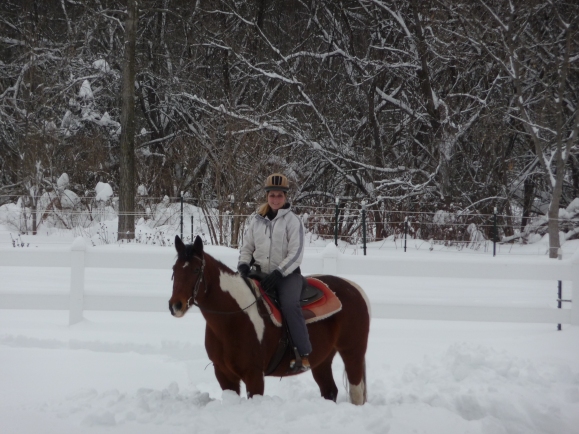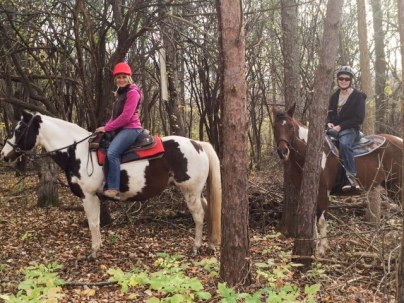No, I am not serious, but that diet is very popular and works for some people. My horses have survived winter and although neither horse had a blanket hiding their body from me, it is now time to evaluate their weight and health and make adjustments if necessary going into the riding season. It is also a perfect time because my veterinarian is seeing my horses for the spring shots and can assist me in making nutrition decisions. I have attended two seminars this winter regarding nutrition and I always learn something beneficial for my horses.


Both of my horses currently have been getting the same food. Since they are easy keepers, during the summer they have 24 hour grass access and then they are supplemented with Nutrena Empower Balance a concentrated controlled starch supplement to balance hay or grass diets. Plus, and maybe a “big” plus, through the winter I gave the girls lots of treats including peppermints, molasses cookies, carrots, apples, and more peppermints. It was part of my whole winter barn fun on a cold day to bond and interact with my horses. The horses, the dog and the cat all got treats after I cleaned the stalls a few times a day. With not much exercise happening, Cheyenne has gained a few pounds from that. Bailey on the other hand, has lost a few pounds as she is a picky eater in the winter when she isn’t getting fresh grass. Both horses are showing off their very furry bodies too.


I have been monitoring Bailey’s weight through the winter and I have made some adjustments in her hay feeding. I am providing Bailey’s hay in regular feeder boxes, not slow feeder boxes with small openings. Although she still seems on the lighter side of the weight chart, with her arthritis, my vet recommends no changes to her diet going into spring.
Now for Cheyenne’s weight. The peppermints have gone right to her hips. So, on March 9 after discussion with my vet, she has been cut off treats. Don’t worry, I can’t deny her the treat experience. I have just altered her treats to be a portion of her Nutrena Empower Balance pellet food. Cheyenne is still getting the same amount of pellets which is a total of 4 measured cups per day, but I just keep a cup separate to dip into when I go out to the barn to give as treats for her. Everyone seems happy so far, and actually I see a slight difference already. Plus, we have had nice weather, so she is getting some exercise herself walking around looking for grass and by me riding her.
Nutrena states: While knowing your horse’s weight is critical to making sure your horse is receiving the care it needs, tracking your horse’s Body Condition Score over time is an ideal (and easier) way to make sure your horse is doing as well as you want him to.
Developed through extensive research by Texas A&M, the Body Condition Score (BCS) is measured on a scale of 1 to 9, with 1 being “Poor” and 9 being “Extremely Fat”. You can easily determine your horse’s BCS by looking at the amount of fat deposited in six key areas of your horse’s body:
1. Along the neck
2. Along the withers
3. Crease along the back
4. Over the ribs
5. Behind the shoulder
6. Over the tailhead



As a general rule of thumb, growing and performance horses, as well as general-use horses, should be kept at a BCS of 4-7, with a 5 being “ideal”. Broodmares should generally be kept at a 5.5-7.5.
Learning how to assign a Body Condition Score may take a little practice, and what you call a 4.5 might be a 5 to your neighbor, but what is most important to your own herd is that you assign scores to each horse, then track them over time to ensure that everyone is receiving all the care they need.
Monitoring body weight
Having an accurate idea of your horse’s body weight is important for a number of reasons;
•To calculate your horse’s ration.
•To accurately identify weight loss and weight gain. Allowing you to keep your horse
or pony at a healthy weight by adjusting feed and grazing accordingly.
•To identify any sudden weight loss which may indicate a health problem.
•To enable the correct dosage and administration of medication, supplements and
anthelmintics (wormers).
•When you see a horse or pony everyday it can be very difficult to identify changes
in condition by eye alone.

How to use a Weight tape
A weight tape is a valuable tool for objectively calculating and monitoring your horses weight. Weight tapes are widely available and inexpensive.
The tape should be placed over the lowest point of the withers passing around the horse about 4” or a hand width from the elbow. The tape should be pulled firmly around the horse but not so that it dents the flesh. The tape will be on a slight diagonal angle when in the correct position. Do not place the tape as you would a girth, ensure the tape passes as close to the elbow as possible.
Figuring out the proper nutrition for your horse and the proper weight is important to avoid health problems. I always reach out to my veterinarians first with my concerns. I also contact my feed company since most quality feed companies have a nutritionist employed to assist horse owners questions. I was pleased to see that both my vet and the feed nutritionist agreed on what I should continue to do for both my horses. For now, the only real change is no treats for Cheyenne. In a month I will see how that has worked and evaluate again.



















